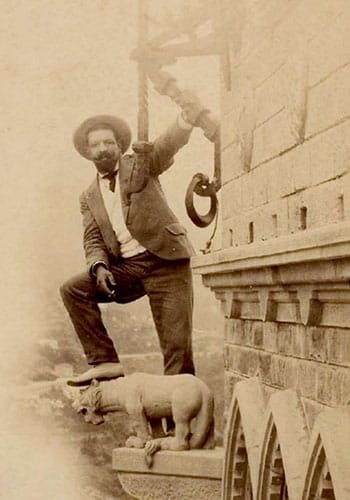Villa Frisoni (Castello di Lupinari)
Gino Coppedè: Master of Eclectic Architecture and the Enchantment of Villa Frisoni
Gino Coppedè (1866-1927) was an Italian architect and decorator, known for his unique and imaginative style that is a combination of neo-Gothic, Art Nouveau, Baroque and Renaissance elements. His works are distinguished by bold compositions, rich decorations and a fairytale-like appearance. Although his most famous creations can be found in cities such as Florence, Genoa and Rome, the Tuscan landscape also harbors a hidden gem of his hand: Villa Frisoni in Lupinari, municipality of Bucine.
Coppedè’s Architectural World
Gino Coppedè’s work is characterized by a unique and almost theatrical approach to architecture. He combined historical styles with a modern sense of drama and detailing. His masterpiece, the Coppedè neighborhood in Rome, is a textbook example of his eclectic vision. This neighborhood, built between 1913 and 1927, consists of lavishly decorated buildings with arches, turrets, mosaics and sculptural ornaments. In Genoa, he designed the famous Castello Mackenzie, an impressive structure with medieval and neo-Gothic influences. His style was appreciated not only for its aesthetics, but also for the way in which he elevated architecture to an art form, with every detail seeming to tell a story.
Villa Frisoni (Castello di Lupinari): A Jewel in the Tuscan Landscape
Villa Frisoni, located in Lupinari in the municipality of Bucine, is a beautiful example of Coppedè’s characteristic style applied to a Tuscan villa. The building exudes the fairytale elegance that is so characteristic of his work. The villa combines medieval and Renaissance elements with the opulence of art nouveau. This results in an imposing yet charming country house that blends perfectly into the Tuscan landscape.
The facade of Villa Frisoni is richly decorated with decorative elements such as carved columns, graceful arches and beautifully crafted wooden balconies. The symmetry and playful ornamentation give the villa a magical appearance, while the classic Tuscan materials such as stone and terracotta allow it to blend harmoniously into the surroundings.
The interior reflects the same grandeur, with high ceilings, detailed frescoes, hand-forged wrought iron details and beautiful wood carvings. The rooms are designed to combine light and airiness with a sense of luxury and history. From the villa, the panoramic view over the rolling hills of Tuscany offers a breathtaking backdrop, making Villa Frisoni not only an architectural masterpiece, but also an oasis of tranquility and refinement.
The Meaning of Villa Frisoni
Villa Frisoni is a hidden treasure in the oeuvre of Gino Coppedè. While his urban projects are often well-known, this villa shows how his eclectic and fairytale style could also be applied in a more rural, aristocratic setting. The villa is not only a testament to Coppedè’s craftsmanship and artistic vision, but also a paragon of refined Italian architecture from the early 20th century.
For lovers of art, architecture and history, Villa Frisoni offers a unique glimpse into the imaginative world of Gino Coppedè. His work remains a source of inspiration for architects and admirers all over the world, and Villa Frisoni is a wonderful example of his work. It is a villa that is not just a property, but an architectural poem, written in stone, wood and decorative splendor.
